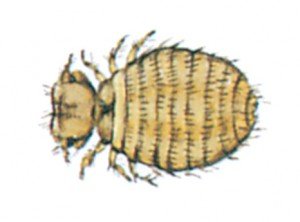
( Latin: Mallophaga )
These insects are somewhat similar in appearance to the true lice, but the head is broader, they usually have two claws on each leg, and they do not suck blood.They feed by gnawing fur and feathers and also scraps of skins. They do not affect man.
Biting lice attach their eggs firmly to feathers or fur and the whole development from egg to adult takes only a couple of weeks. They are so dependent upon the warm, damp climate under feathers or among fur that they only survive for a few hours after the host animal dies.
Dogs and cats each have their own species of biting louse known respectively as Trichodectes canis and Felico/a subrostratus. Apparently these cause irritation, for animals carrying them scratch continuously.
Cage birds may also become infested with feather lice, and these cause a lowering in conditions for the birds. In the wild, many birds attempt to rid themselves of lice by taking dust baths, but this is not really practicable in the case of cage birds, which should be treated with a suitable insecticide.




